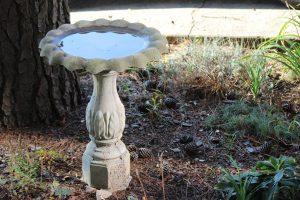Edwardsville earns Pollinator Pathway designation
June 29, 2023

Residents can help the pollinator population with simple actions such as keeping a bird bath filled with clean water, according to Pollinator Pathway project group
A communitywide effort has led Edwardsville to become Illinois’ first official Pollinator Pathway city.
Mayor Art Risavy made the announcement at the Tuesday, June 20, City Council meeting, recognizing efforts of the multiple organizations and residents who worked toward the goal.
“This is a wonderful accomplishment,” Risavy said. “I appreciate the work of all involved to make this possible.”
He asked for the public and council members to share their ideas and involvement to ensure the vision and project is a continued success.
The designation as a Pollinator Pathway city comes from the nonprofit Pollinator Pathway group that fosters the efforts of communities and their volunteer groups “working together to establish pollinator-friendly habitat and food sources for bees, butterflies, hummingbirds and other pollinating insects and wildlife along a series of continuous corridors,” as stated on the organization’s website.
Illinois is now the 15th state with at least one designated Pollinator Pathway city.
Mary Grose, who was involved in Edwardsville’s effort and is a founding member of the Good Dirt Community Garden which is based at the Edwardsville YMCA Meyer Center, told those present at the council meeting Edwardsville had qualified to be designated as a Pollinator Pathway city through ongoing projects.
The last steps needed to officially complete the designation is submission of forms and descriptions of the various local groups’ native gardens and prairies.

Edwardsville Mayor Art Risavy
In addition to Good Dirt Community Garden, other organizations that contributed to the effort include the City’s Beautification and Tree Commission; the Edwardsville Children’s Museum; the Nature Preserve Foundation and Watershed Nature Center; the Center for Spirituality and Sustainability at Southern Illinois University Edwardsville; HeartLands Conservancy; Dunlap Lake Property Owners Association; Liberty Middle School, which is part of the Edwardsville School District; the 1820 Col. Benjamin Stephenson House; and Madison County Transit.
“There were all these organizations that were doing similar things in their own little bubbles,” said Sarah Cundiff, the chair of the city’s Beautification & Tree Commission. “This was a way we could link these bubbles together, share resources and knowledge and work together for the greater good.”
The project involves more than just nonprofit or governmental groups. Residents and businesses also can participate and submit their pollinator-friendly gardens and areas to be listed on the Pollinator Pathway national map, Grose said.
The Pollinator Pathway project aims to address the declining population of pollinators, such as native bees and monarch butterflies, which the organization notes is largely due to loss of habitat and pesticide use. One of the easiest ways to help is to use native plants in flower beds and gardens.
“Native plants’ value lies in the fact that they are adapted to the local climate and soil conditions where they naturally occur,” Grose said.
Most native bees have a range of about 750 meters, so the goal is to connect properties that are no farther apart than that, according to the Pathway group.
Other tips include providing a clean water source — a bird bath or fountain, for instance; leaving plant stalks, leaves and pieces of dead wood on your property in the colder months to provide food and habitat for wildlife; mowing less often and reducing or eliminating the use of pesticides.
Public and private pesticide-free corridors of native plants that provide nutrition and habitat for pollinating insects and birds. Even the smallest green spaces, like flower boxes and curb strips, can be part of a pathway, according to pollinator-pathway.org.
Most native bees have a range of about 750 meters, so the goal is to connect properties that are no farther apart than that, according to the Pathway group.
To learn more about the Pollinator Pathway project and participating sites in Edwardsville, visit www.pollinator-pathway.org/towns/edwardsville.
A link also will be available on the Beautification and Tree Commission’s page on the city’s website: www.cityofedwardsville.com/274/Beautification-Tree-Commission.



